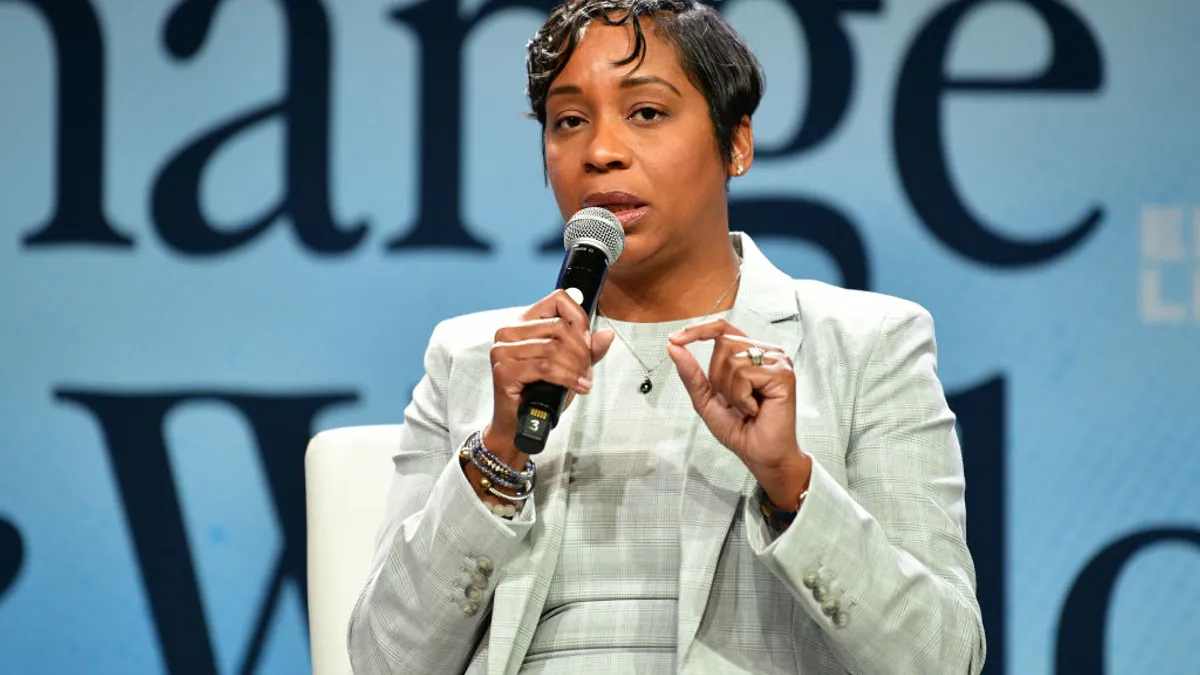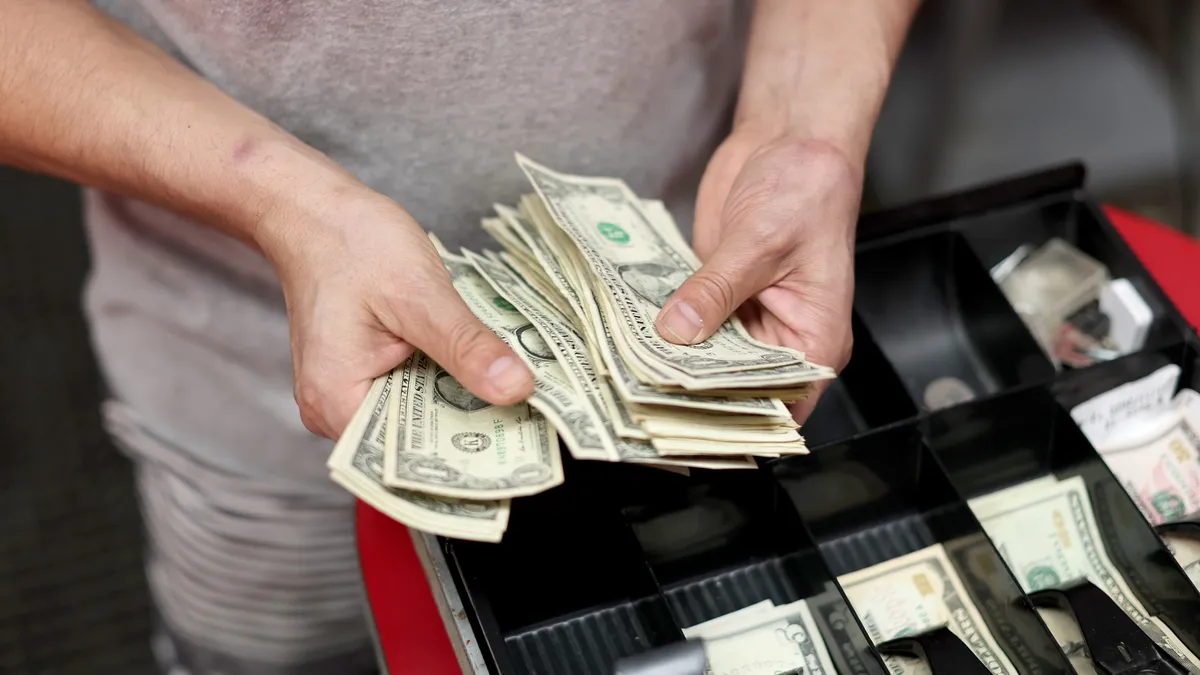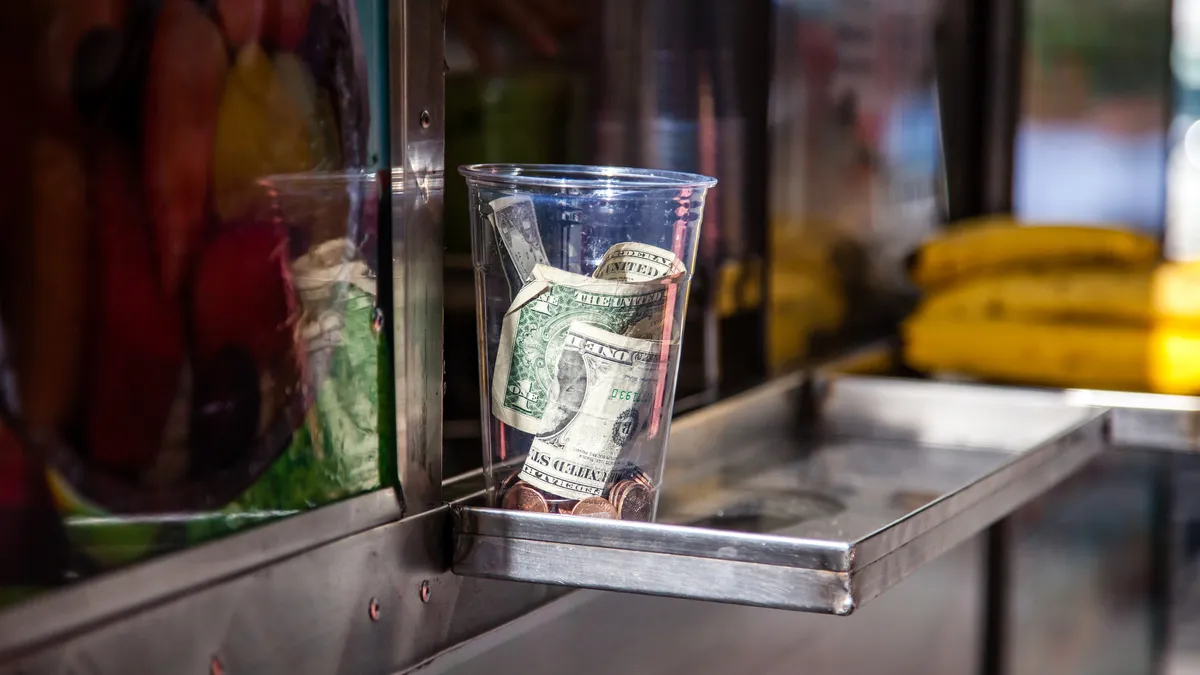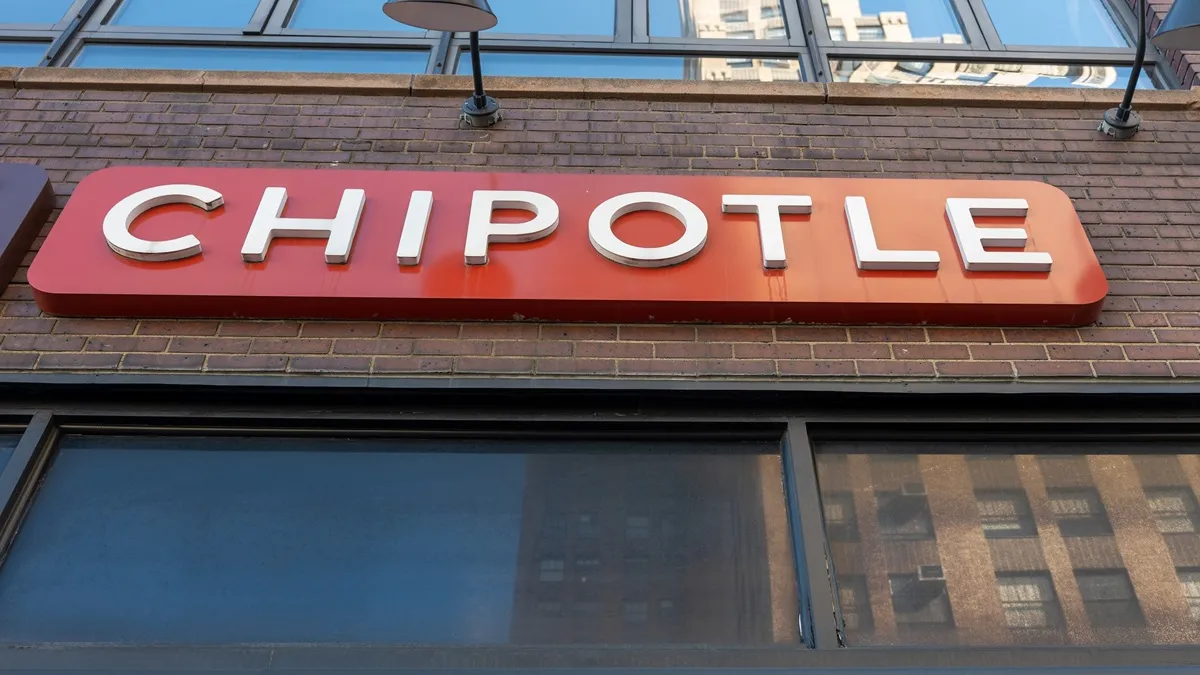This is the second article in a three-part series exploring strategies and techniques restaurants should consider before and after they reopen. The first in the series explored whether or not restaurants were ready to reopen amid social distancing restrictions and can be viewed here.
Alex Smith, CEO of Atlas Restaurant Group, has already formulated a plan for reopening with social distancing restrictions. The co-owner of the group of full-service restaurants, most of which are in Baltimore, plans to bring back his employees seven days before Maryland’s governor allows dining rooms to reopen, Smith told Restaurant Dive. That date is currently unknown, but restaurants would be part of the governor’s second phase of reopening.
“There are all these new normals that we’re going to have and our employees are going to have to go through training to make sure that our guests’ safety and employee safety is No. 1,” Smith said.
Atlas Restaurants, which employed 1,000 people before the pandemic, furloughed 900 team members and closed 14 of its 15 restaurants following dine-in restrictions, Smith said. The company retained key managers and corporate officers, which allowed it to keep an infrastructure in place to make it easier to reach out to employees and get organized once it is ready to reopen, Smith said.
“Our goal is survival,” Smith said. “Our goal is getting our Atlas family back to work.”
Once Atlas’ employees come back, Smith’s company will provide a training program to get people oriented to what that new normal will look like for his restaurants, which will include front-of-house staff wearing masks and employees wearing gloves, he said.
The restaurant group will have hand sanitizing stations separate from the bathrooms and will arrange tables so that they are six feet apart, with no more than six people seated at each table, he said.
As more states ease dining room restrictions, restaurants will need plans like these to properly bring their employees back and ensure they minimize employee and diner exposure to COVID-19.
Restaurant Dive spoke to several restaurant experts on employee and food safety issues that operators should keep in mind before and after they bring back furloughed employees to make sure they stay safe.
1. Reassess payroll practices and compliance
Operators should think of this time as a reboot, and take the opportunity to review payroll practices, policies and procedures for legal compliance, Alden Parker, co-chair of Fisher Phillips Hospitality Industry Group, told Restaurant Dive.
That could mean reviewing how restaurants treat meal and rest period compliance in states that have guidelines for these periods, he said. Operators could use this time to ensure they have the correct classifications for employees, such as whether assistant managers are properly classified as exempt or if they should be hourly and qualify for overtime. Now is also a great time to review tip pooling policies to make sure those are in compliance as well, he said.
One of the biggest things operators should be taking a look at is whether they should institute an arbitration agreement with a class-action waiver, he said.
With restaurants essentially starting back up like new businesses, employers have time to consider creating a system where employee issues would go through private arbitration versus leaving it open to potentially become a class-action case that goes through the court system, he said.
“It’s an excellent time to revisit those [policies] and put some effort into that before you start hiring people and putting them back on the books,” Parker said.
2. Set up policies for rehiring
Rehiring could be particularly troublesome because it could open up operators to charges of bias, according to Law360. One way to prevent this from happening is to rehire based on seniority by bringing back servers and other staff that have been with the restaurant the longest, Parker said. Los Angeles is even considering a mandate requiring individuals to be rehired based on seniority.
Owners should also be tracking offer letters and whether employees accepted or declined their offer, Parker said. That way if the offer is passed on to a less senior employee, there is documentation backing that move, he said.
Many operators are concerned that the $600 per week that comes through unemployment benefits will be difficult to compete with when it comes time to rehire employees, Parker said.
“Restaurants and other small businesses are having trouble because … with the way that the unemployment benefits are, there are people who literally have to make a choice whether to go back to work and take less than they are getting right now or stay home,” David Bagley, managing director at Carl Marks Advisors, told Restaurant Dive. Carl Marks Advisors provides financial and operational services to companies in the middle market, including the restaurant sector.
“Restaurants are going to need to be on the front of that because they’re going to need to get their people back. … And they’re going to need to potentially recruit [former employees],” Bagley said.
Rehiring will be easier for larger restaurants and their franchisees because hiring is much more standardized by these organizations, whereas a small restaurant may not have the resources to easily hire someone and get them up to speed, Bagley said.
Some operators might need to increase pay for a short period of time to make up for the difference from what they could potentially get on unemployment, as well as changing operating hours or, as a last resort, increasing menu prices and calling it pandemic pricing, Bagley said. Chains like Starbucks, Chipotle, Darden and Domino’s have instituted short-term pay increases and/or bonuses for employees that are still on the job.
But maintaining increased wages long term would be particularly difficult and could force restaurants to employ fewer people, which could make service suffer, Bagley said. There are also fixed costs like rent and food that can’t necessarily be decreased to make up for higher labor costs, he said. Increasing menu prices could also be tricky with so much competition coming from people who are cooking at home, he said.
How restaurants approach this issue will be a case-by-case basis, Bagley said, adding that there really isn’t one answer for everyone.
3. Develop training for new sanitization, social distancing standards
Training will be key to bring employees up to speed with the many new social distancing and sanitization regulations that states and municipalities require.
This might look like a mandatory post-pandemic training session for employees before they return to work, according to a Streetsense Restaurant + Bar Relaunch Toolkit emailed to Restaurant Dive. These trainings should have clear, redefined and systemized new sanitation procedures that should be reinforced on a daily basis. Teams could make this into a fun process with things like games or small rewards for compliance with the new standards to help reinforce these guidelines, according to Streetsense.
Training should include strategies that help employees maintain social distancing from each other and customers, review coughing and sneezing etiquette, proper use of face coverings and gloves, and provide an emphasis on hand washing, Chris Boyles, VP of food safety at Steritech, told Restaurant Dive. Steritech conducts over 300,000 assessments a year in the areas of food safety, service excellence, workplace safety and guest experience.
“The proper cleaning and sanitizing practices always required in foodservice operations have not changed; it is the increased attention these practices are receiving that will ultimately make them embedded in the food safety culture of restaurant operations,” Boyles said.
4. Set up daily cleaning protocols
Ongoing cleaning procedures will reduce the risk of exposure for employees and customers. Cleaning should include disinfection of high contact surfaces in the front- and back-of-house including, but not limited to, door handles and frames, countertops, POS equipment, headsets, buttons on equipment and any shared items on a table top, Boyles said.
These kinds of cleanings should be done between seatings, and silverware and preset tables should be replaced with single-use items, the National Restaurant Association said in its COVID-19 Reopening Guidance emailed to Restaurant Dive.
Operators should train and designate employees for extra disinfection duties, but make it an important role and not just a janitorial task, Boyles said. These employees should receive personal protective equipment and supplies. Restaurants should also consider a third-party cleaning and disinfection service periodically.
Food surfaces in the back-of-house should also be cleaned and sanitized, but if a disinfectant is used on these surfaces they should be rinsed before food touches the surface, he said.
Restaurants should keep in mind the added cost regular disinfection will have on their operations since disinfectants will be used more frequently, Boyles said. Operators also will have to take the time to evaluate and select new products if their current disinfectant isn’t designated to work effectively against COVID-19, Boyles said.
“Added labor costs may be necessary to have designated persons responsible for the more frequent disinfecting process, so this needs to be considered when planning for labor needs,” Boyles said.
If a restaurant has to close due to contamination of the premises due to a COVID-19 positive person and is ordered to close by the health department, there may be added costs to hire a third-party disinfection service as well, Boyles said.
5. Monitor employee health
Checking employees’ health and fitness should be among the top priorities to ensure that employees aren’t coming to work ill. Many restaurants are doing temperature checks and using health questionnaires, Parker said. While this would normally be considered a medical examination by the Equal Employment Opportunity Commission, the agency has relaxed that standard during the pandemic allowing screenings to occur so long as they are job-related. Other restaurants, such as McDonald’s, have been creating health questionnaires to monitor their employees on a daily basis to see if they have symptoms.
If employees are sick, symptomatic, exposed or confirm they have a food borne illness or COVID-19 they should not report to work, Boyles said. Employers should also work with HR to develop or modify their sick day policies so that employees are not afraid of losing their jobs if they get sick, he said.
If an employee does contract COVID-19, they should get a return-to-work notice from a healthcare professional, Parker said, adding that is a danger point if a restaurant denies allowing that employee to work out of an abundance of caution even when they are cleared.
“The other side of that coin is someone that gets COVID-19, goes through this 14-day period of time, and the doctor doesn't clear them,” Parker said. “Many employers will read the 14-day guideline and say, ‘Okay, you must be over it. Now let's get back to work.’ And if a healthcare professional is saying, ‘This person is still symptomatic or still susceptible to it.’ … If that’s the case, then the employer is going to have to consider … whether additional leave can be offered to the person.”
There will be plenty of ways to provide sick leave to employees, as well. Emergency paid leave granted under the Families First Coronavirus Response Act and additional paid leave under the Family and Medical Leave Act carry through the end of the year, he said. Employees in states with paid sick leave provisions would also have their sick day banks restored if they were furloughed and rehired, Parker said.
If employees that get sick on the job and COVID-19 exposure is traced to the workplace, employees would be able to file a workers compensation claim if the operator followed all the safety precautions, Parker said. However, this could become a serious and willful claim allegation if an employer ignores safety guidelines set by the Occupational Safety and Health Administration and the Centers for Disease Control and Prevention. Employees can then claim that the operator created an unsafe work environment. That can result in increased workers comp penalties or this could be taken out of workers comp and filed as a civil action in some states, he said.
It’s also important for operators to understand that despite their efforts, there may not be a way to completely protect employees from exposure.
“To a certain extent there’s going to be some risk borne by the individual,” Parker said. “There is going to have to be if anybody’s ever able to get back to work.”
For more information on strategies and procedures for reopening, check out National Restaurant Association’s COVID-19 Reopening Guidance and Streetsense’s Pandemic Relaunch Toolkit for Restaurants + Bars.






















